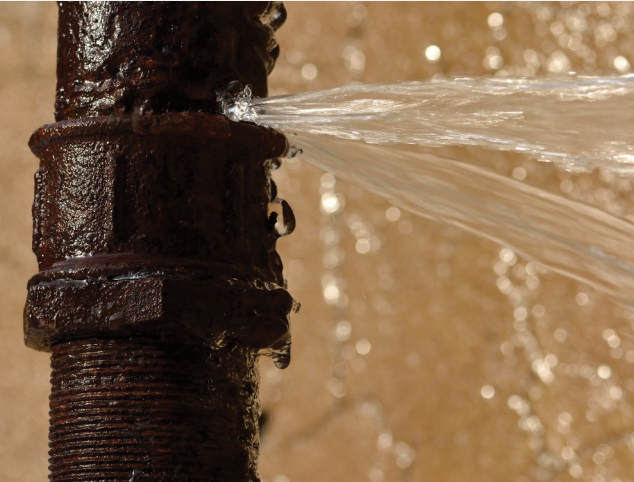“Water, water everywhere” is not what you want to be thinking as you’re staring through the windows of the restaurant, drug store and appliance shop that are tenants in the building you own. Water inside a building means likely damage to the furnishings and fixtures, floors and walls inside; it also means the possibility of rotting wood and mold risks; and it means major liability risks.
“Water intrusion,” which is how engineers define the problem, can have many causes, but the most common is construction flaws in a building’s envelope – the vertical surfaces running between the foundation and the roof that separate the interior from the exterior.
The envelope should be water-tight, for obvious reasons; unfortunately, we find that is not the case in many of the commercial buildings we analyze. For purposes of this discussion, we are not talking about “trophy buildings” – the towering skyscrapers that define an urban landscape. We’re talking about the small strip malls with a handful of stores that are ubiquitous in the suburbs. The buildings are low-rise – typically only one-story—and they are usually managed by their owners or by small property management companies, which may in itself increase their vulnerability to water intrusion problems.
Compared with a corporate owner or a management company overseeing multiple large-scale properties, individuals who own and manage small strip malls are likely to be excessively cost-conscious (which sometimes means “penny-wise and pound-foolish”), and inclined to push building components, like the roof, to the end of their life expectancy, patching rather than replacing them when problems appear.
An older roof, oft-repaired, is more likely to leak than a newer one (that is well installed, not all are) or one that has been consistently well-maintained. Leaks in a well-maintained roof will usually be relatively small and isolated; leaks in a neglected roof are likely to be larger, more widespread, and more damaging as a result.
The flat roofs common in commercial buildings are also more prone to leaks than slanted ones. And small commercial properties are particularly vulnerable to roof damage caused by third parties. Commercial tenants are usually responsible for building out their spaces. A mall with eight spaces could have eight different tenants with eight different contractors, all dispatching different workers to install or connect equipment on the roof. The more people traipsing around a roof, the more opportunities for someone to drop a tool, dig a heel, fail to seal an opening, or otherwise damage or weaken the surface in ways that aren’t likely to be discovered until the roof starts to leak.
When we are looking for the source of water intrusion, a damaged or neglected roof is always a prime suspect, but by no means the only one. Architectural features also rank high on the suspect list. Consider the glass storefronts and glass curtain walls that are standard in strip malls. Poorly installed windows are a leading source of water intrusion in residential buildings. The problem is magnified in malls, because they have a lot more glass that requires a lot more maintenance to keep the installations water-tight.
Malls don’t have balconies – another intrusion point in residential structures. But they do have loading docks that are not always treated tenderly by the truck drivers who back into them. Cracks in the docks can funnel water into the building.
The building’s siding can also be problematic. Experts will debate endlessly the relative advantages of different siding products, and there is no question that some are better than
others. But if water is seeping into the building, we find it is most often the quality of the installation, not the quality of the product that is at fault.
For example, Exterior Installation Finish Systems (EIFS) are now widely used in commercial structures. Comprised of a synthetic material that resembles stucco, the finish looks smart and works well – if installed properly. But if the insulation is inadequate or if transitions aren’t sealed properly, the surface won’t be water-tight.
One of the most common installation mistakes is the incorrect layering of building envelope materials. When this occurs, instead of being shed efficiently from one material to another, water accumulates behind the materials and penetrates the structure.
Design features intended to increase the visual appeal of a building can also increase its water intrusion risks. Varying the materials, using different shapes and inserting angles all add architectural interest. But if the different materials used are incompatible, the resulting temperature variations can cause sealants to fail. And every angle you create, every transition you make from one shape or material to another, creates a point at which water may intrude. Transition or termination points represent a tiny portion of a building’s envelope, but they account for much of its vulnerability, and they don’t always receive the water-proofing attention they need.
There are no perfect buildings. Water intrusion is a potential risk for all. But owners of commercial buildings can reduce their risks by being mindful, diligent and proactive. Here are a few suggestions:
- Don’t ignore early signs of water intrusion. If you see water stains on ceilings or walls, don’t ignore them. The sooner you identify the source of water intrusion problems, the more controllable they will be.
- Bring in experts to investigate. They can provide the objective analysis you need and they can be held accountable for their findings. Often, properly performed water tests are necessary to definitively diagnose water intrusion.
- Take care of preventive maintenance. This includes more than painting or power washing the exterior. Replace (and, if necessary, upgrade) the sealants around the perimeter of windows and curtain walls. This is your best defense against water intrusion in those areas. Good sealants last a long time, but they don’t last forever. Experts suggest re-sealing every 5 years on average – less frequently in some parts of the country, more frequently in others, depending on the climate. Preventive maintenance should also include an annual roof inspection performed by an expert. Make necessary repairs when they are indicated and make sensible decisions about when it is most cost-effective to replace the roof rather than to continue patching it.
- Consider flooding risks. Although most water penetration risks are centered on the building envelope, ground level flooding may also be a concern for small commercial properties, because they are often built on less than optimal flat sites with less than optimal drainage systems. A heavy rain that floods the parking lot could flood the building as well. A civil engineer can help you asses the flood risks for your property and recommend any mitigation measures you should implement.
- Don’t look for short-cuts. There are no Band-Aids for water intrusion. If transitions on the building’s surface weren’t set properly, you have to re-do them. If the siding wasn’t installed properly, you may have to replace it. If the roof is failing, you‘ll have to replace it, too. These measures are going to be expensive. But preventing water intrusion will be far less costly than repairing the damage it can do to your buildings, to the property and health of your tenants, and to your finances.
The Engineering Advisor is intended to enhance your knowledge of technical issues relating to buildings. For additional information on any subject, please feel free to call us. Our commitment is to provide you with timely, accurate information.
 Ice forming inside of pipes often is not the cause for pipes breaking. Rather, water pipes typically break when an ice blockage occurs and the freezing and expansion causes an increase in pressure between the ice blockage and a closed faucet downstream of the blockage. Pipes that are protected by heat or insulation are typically safe, while pipes in crawlspaces, attics, and outside walls are vulnerable to freezing. Extremely cold weather and holes in the exterior for things such as telephone wire, cable, gas lines, etc. can allow cold air to come in contact with water pipes.
Ice forming inside of pipes often is not the cause for pipes breaking. Rather, water pipes typically break when an ice blockage occurs and the freezing and expansion causes an increase in pressure between the ice blockage and a closed faucet downstream of the blockage. Pipes that are protected by heat or insulation are typically safe, while pipes in crawlspaces, attics, and outside walls are vulnerable to freezing. Extremely cold weather and holes in the exterior for things such as telephone wire, cable, gas lines, etc. can allow cold air to come in contact with water pipes. 
 Typically when I am discussing water problems with the condo’s property manager or the board, the focus is on leaking roofs, foundations, windows, or other building envelope points of water infiltration. Instead, this article’s focus will be on water damage problems from inside sources and their prevention.
Typically when I am discussing water problems with the condo’s property manager or the board, the focus is on leaking roofs, foundations, windows, or other building envelope points of water infiltration. Instead, this article’s focus will be on water damage problems from inside sources and their prevention.